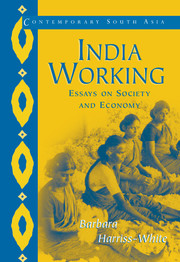Book contents
- Frontmatter
- Contents
- Preface and acknowledgments
- List of maps, figures and tables
- Glossary
- Abbreviations
- 1 Introduction: the character of the Indian economy
- 2 The workforce and its social structures
- 3 Indian development and the intermediate classes
- 4 The local State and the informal economy
- 5 Gender, family businesses and business families
- 6 India's religious pluralism and its implications for the economy
- 7 Caste and corporatist capitalism
- 8 Space and synergy
- 9 How India works
- 10 Postscript: proto-fascist politics and the economy
- Appendix 1 Liberalisation and Hindu fundamentalism
- Appendix 2 Relations between the developmental State and the intermediate classes
- Appendix 3 Roles of religious minorities in the Indian economy
- References
- Index of names
- Index of places
- Index of subjects
2 - The workforce and its social structures
Published online by Cambridge University Press: 06 July 2010
- Frontmatter
- Contents
- Preface and acknowledgments
- List of maps, figures and tables
- Glossary
- Abbreviations
- 1 Introduction: the character of the Indian economy
- 2 The workforce and its social structures
- 3 Indian development and the intermediate classes
- 4 The local State and the informal economy
- 5 Gender, family businesses and business families
- 6 India's religious pluralism and its implications for the economy
- 7 Caste and corporatist capitalism
- 8 Space and synergy
- 9 How India works
- 10 Postscript: proto-fascist politics and the economy
- Appendix 1 Liberalisation and Hindu fundamentalism
- Appendix 2 Relations between the developmental State and the intermediate classes
- Appendix 3 Roles of religious minorities in the Indian economy
- References
- Index of names
- Index of places
- Index of subjects
Summary
Nothing is ever produced without labour. In a capitalist economy labour is taken and turned into labour power; so the way this power is organised and disciplined shapes the accumulation process. In this chapter we will see how social and political institutions that discipline and regulate labour and labour power fuel accumulation and contain the conflicts generated by capitalist growth. Even trade unions play roles that facilitate backward forms of accumulation and the practices of ‘flexible employment’ which characterise advanced capitalism have long been established in India and are crucial to accumulation.
India's economy is about the size of Belgium's, but for every Belgian there are a hundred Indians competing for livelihoods. Out of the country's huge labour force of over 390 million, only 7 per cent are in the organised sector (that is, are workers on regular wages or salaries) in registered firms and with access to the State's social security system and its framework of labour law. Even the term ‘organised’ is seriously misleading because only about half of that 7 per cent are unionised, and we will see later that in India unions are deliberately disorganised. The rest – variously estimated at between 83 and 93 per cent of the workforce – labours in the ‘unorganised’ or ‘informal’ economy. In fact, India's economy is ‘unorganised’. All this ‘unorganised’ labour is unprotected by the regulatory regime of the State because what little exists is not enforced.
- Type
- Chapter
- Information
- India WorkingEssays on Society and Economy, pp. 17 - 42Publisher: Cambridge University PressPrint publication year: 2002



